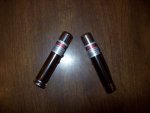Re: Understanding the simplicity of Daedal's circu
In current source mode the LM317 essentially acts as a variable resistor.
It will vary its "resistance" until the current that flows through it is equal to the design current (1.25V drop across the sense resistor).
If this is not possible due to the source voltage not being high enough to meet the minimum drop-out requirements, it will fall out of regulation and not provide the designed current. In this case, the actual voltage measured across the sense resistor will be less than 1.25V.
In current source mode, because the LM317 acts as a variable resistor, it is desirable to ensure the source voltage will meet the minimum drop-out voltage for the range of inputs (i.e. fresh battery to nearly depleted ones).
For example,
Let's say the input voltage is 12 volts, the load voltage is 3 volts at 250mA.
The sense resistor would have to be 5 ohms and it would have a voltage drop of 1.25V.
So we have 3 volts across the load and 1.25 volts across the resistor.
10 - 3 - 1.25 = 5.75V That's whould be the voltage across the LM317.
That poor little LM317 is sinking 1.44Watts (5.75V x 0.25A).
The load is only getting 0.75Watts. The sense resistor is consuming 0.3125Watts. The power source is providing 2.5Watts and only 3/4 of a watt is getting to the load. The circuit is 30% efficient! If this is squeezed into an enclosed space like a flashlight head, then some of that excess heat is going to flow towards the LD.
I hope this helps clear things up for folks.
Daedal said:
It is true that LD's act just like any other diode. They cause a voltage drop in the circuit.
Perhaps you are right about the diode not taking any of the extra voltage, and I would assume and I verified that your measurements are correct.
I'll have to figure out eventually where that extra voltage is going... I'm too sleepy to think now... ;D
--DDL
 ... ;D
... ;D



